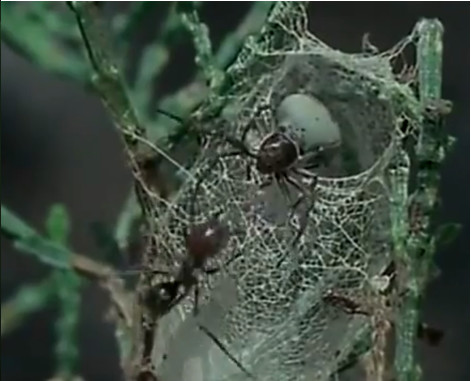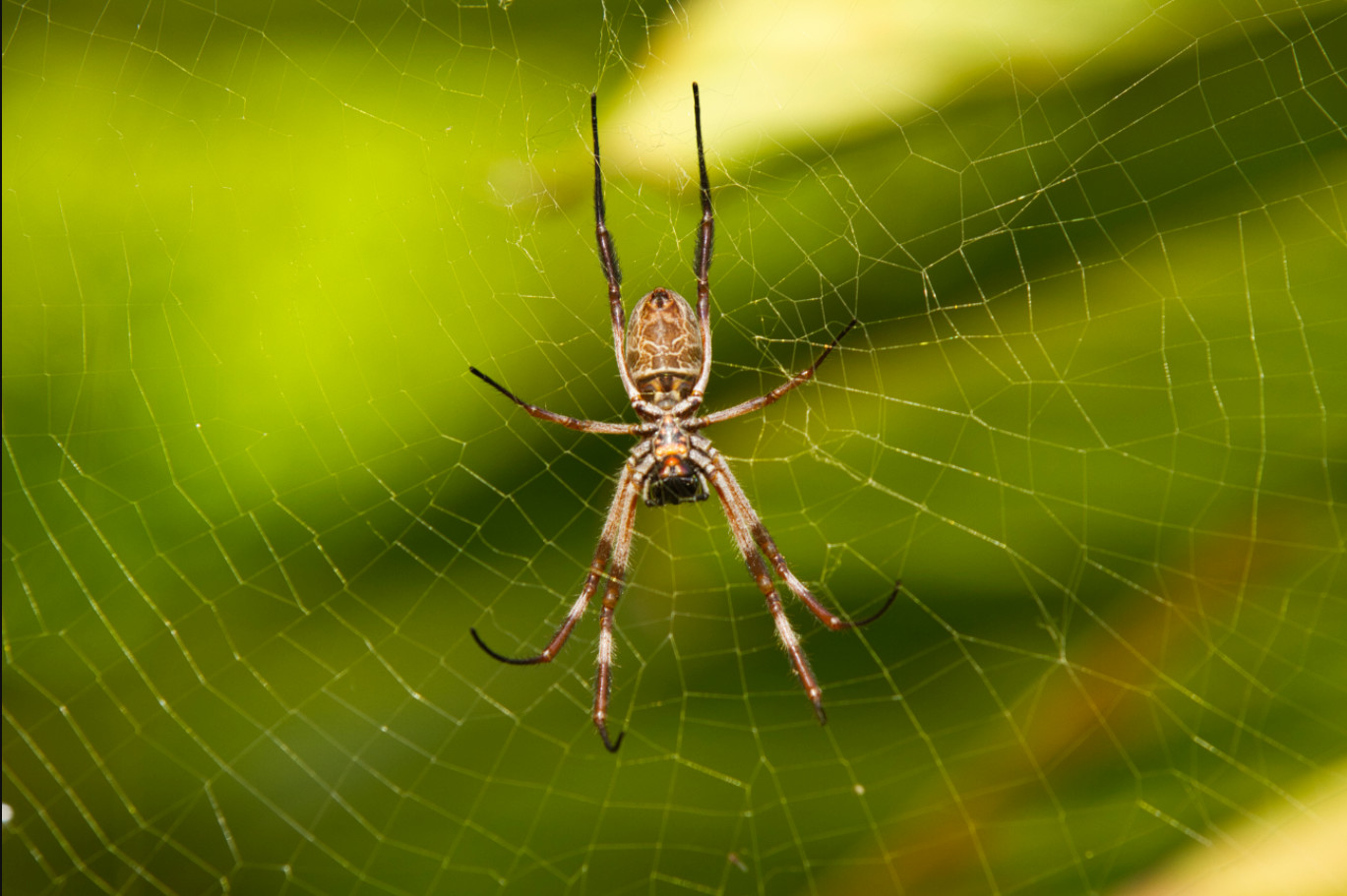
Sciences & Technology
It’s not just antenna size, but scales that matter for lonely male moths

The only spider known to weave a container to catch prey, researchers now have the first insights into the evolution and structure of the basket-web spider’s rare silk
Published 19 October 2020
Ants make remarkably formidable enemies – even for humans – which may explain why they are so rarely included in the diet of most insect-eating animals.
Ant weaponry can include biting and stinging, often injecting neurotoxins or spraying chemicals such as formic acid.

So it’s understandable that many species take advantage of ants’ fierce reputation by mimicking their body shape, a strategy that has evolved even in some less aggressive species of ants.

Sciences & Technology
It’s not just antenna size, but scales that matter for lonely male moths
Other species use chemicals to keep ants at bay.
Native sugarbag bees line the entrance hole of their nests with a substance that includes an ant-repelling odour, and ants rarely venture onto the web of orb spiders because the silk contains an ant-repelling chemical.
Nevertheless, some species still manage to feed safely on ants. It’s a lifestyle choice for Australian echidnas, who use their long sticky tongues to extract ants from the nest.
Some insects and spiders venture into the ant’s nest, where they feed on the vulnerable ant larvae. This is not without risk of attack, and may involve wearing a chemical ‘cloak’ that mimics the odours of the ants, concealing their true identity.
A less risky approach is to capture ants away from their nest – even better if they can be safely contained in a confined space that prevents a bite or sting.
This sensible procedure is widely used by entomologists when collecting ants to study, but is also a solution that evolved somewhat earlier in the remarkable Australian basket-web spider, which constructs a web resembling a lobster pot.

Unsuspecting foraging ants that walk into the enclosed basket cannot escape, and are subsequently overcome by the resident spider.

Sciences & Technology
Genes don’t always dictate that ‘boys will be boys’
Of course, many spiders build webs, but the basket weaver’s has a unique feature: the silk is rigid, so the basket-like web retains its structural integrity without help from the surrounding vegetation.
As far as we know, no other spider builds a web like this.
The entomologist William J. Rainbow, who formally described this spider in 1900, did not mention this feature of the silk, perhaps because he had only seen drawings of the web and imagined it was more sack-like.
In fact, this is how the spider gained its scientific name Saccodomus formivorous after Rainbow noted the basket-web spider “constructs a bag-like nest”, from which it derives is generic name Saccodomus.
Now, more than 120 years later, an international collaboration between the University of Melbourne, University of Bayreuth and ANSTO, has provided the first insights into how the silk retains its rigid structure, allowing the spider to make a robust and rather exquisite silken basket.
My interest in the basket-web spider was piqued by a wonderful documentary, Webs of Intrigue produced by the late naturalist Densey Clyne and Jim Frazier (inventor of the award-winning Frazier lens).

They captured images of ants walking over the outside of the basket web and entering into it through a small hole at the top.
The resident spider uses its legs to tap the surprisingly unaggressive ant worker, apparently luring the ant to enter the basket web, where it is eventually captured.

Sciences & Technology
Darwin was right: Females prefer sex with good listeners
In 1995, I drove to the Warrumbungle National Park, to see these spiders and webs in their natural habitat. But it wasn’t until 20 years later, when I was introduced to Professor Thomas Scheibel of the University of Bayreuth, an expert on the material properties of spider silk, that this research project began.
That summer, I drove 2,000 kilometres to collect basket-web spiders for Professor Scheibel and his doctoral student Christian Haynl, so that we could work toward understanding the nature of this silk.
Sadly, the spiders could not be found in the Warrumbungle National Park, after becoming victim to the very severe 2013 bushfire, although they were found elsewhere in New South Wales.
The baskets are approximately 11 millimetres in diameter and 14 millimetres deep, comprising of cross-linked threads of varying diameters. The basket webs were firmly attached to branches and leaves by protruding threads originating throughout the web.
One of the first things we discovered is that the spider incorporates an egg case at the base of the basket.

The biochemical composition of the silk thread, including secondary protein structures and saccharide (sugar) components, were examined on the Infrared Microspectroscopy (IRM) beamline at the Australian Synchrotron, an ANSTO national research facility.

Sciences & Technology
The grasshopper that was lost, then found, is now endangered
Located in Clayton, Victoria, the Australian Synchrotron is a giant machine, about the size of a football field, which accelerates electrons to almost the speed of light.
Electrons deflected through magnetic fields create extremely bright light that reveals molecular and atomic details at micrometer (one thousandth of a millimetre) and sub-micrometer scales – something not possible using laboratory-based instruments.
The high-resolution infrared technique, unique to the Austalian Synchrotron’s IRM beamline, revealed that the remarkable lateral resilience, or stiffness of the basket web silk, is due to the synergistic or complimentary arrangement of their fibres.
The silk microfibres, with a diameter of about two to four micrometres are embedded in a polymer matrix, consisting of much thinner fibres arranged in a longitudinal direction.
These smaller sub-fibres contain different molecular building blocks to those of the larger micro-fibres and are about one tenth as thick.

Unexpectedly, the silk used to construct the basket web turned out to have similar characteristics to the silk produced by many species to wrap around their eggs – which provides protection from the elements or enemies, and is unlike the silk used to construct typical foraging webs.

Sciences & Technology
Would cockroaches really survive a nuclear apocalypse?
Our discovery may provide insights into the evolution of foraging webs.
It is widely thought that silk foraging webs, including the magnificent orb-webs, evolved from the habit of producing silk to protect egg cases.
The basket-web seems to be an extension of the protective egg case and may represent the first documented example of a spider foraging web that has evolved as an extension of the protective egg case.
It’s entirely possible that the newly discovered properties of basket-web silk will add to the myriad uses of spider silk that have already inspired applications in the clothing and medical industries.
More generally, the properties of its silk highlight the importance of continuing to investigate obscure, unfamiliar species.
There is increasing recognition that solutions to many of the complex challenges and puzzles we face today can be found from biological systems.
This so-called bioinspiration draws on some 3.8 billion years of natural selection honing biological forms, processes and systems. The potential insights from that diversity of life, about which we still know rather little, are staggering.
Banner: Mark Elgar/ University of Melbourne